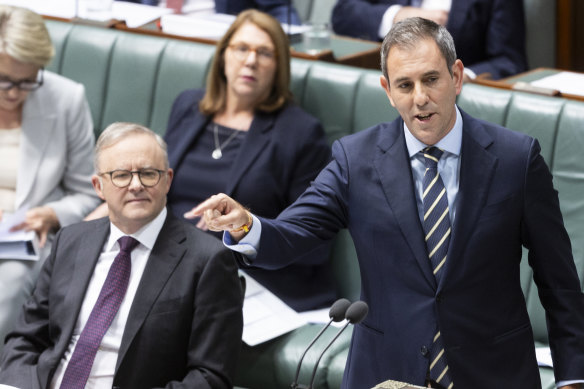Save articles for later
Add articles to your saved list and come back to them any time.
Superannuation funds representing $2.5 trillion will be pushed to fill a widening deficit in defence, energy and social services spending as Treasurer Jim Chalmers meets executives on Monday seeking hundreds of billions of dollars of private investment in crucial sectors of the economy.
The Albanese government is assembling what is believed to be the highest net worth group of investors to meet in Australia because taxpayers cannot afford to bankroll some of its most high-profile initiatives.
Treasurer Jim Chalmers says the roundtable is about “delivering strong returns for investors and strong returns for our people”.Credit: Alex Ellinghausen.
“This week, we’re bringing the most influential investors and philanthropists in the country around the table to get capital flowing to where it’s needed most in our economy,” Chalmers said.
“Our investor roundtables are all about getting capital flowing towards opportunities that are in the national interest, delivering strong returns for investors and strong returns for our people.”
Building a fleet of nuclear-powered submarines is expected to cost nearly $400 billion over 30 years. While the commitment to defence spending cracked $50 billion for the first time in the federal budget this year, the nuclear submarines are unfunded.
Defence Industry Minister Pat Conroy said the roundtable would discuss the potential for “everyday Australians to invest in the defence of their nation”.
“It will explore innovative ways of unlocking private capital to support Australian businesses that have developed capabilities Defence has identified as a priority acquisition,” he said.
Meanwhile, Commonwealth Bank senior economist Kristina Clifton said switching to renewable electricity generation and electrifying the transport sector could cost up to $100 billion a year until 2050.
Competition for clean energy investment is expected to soar, with Australia joining more than 110 countries at the United Nations annual climate summit, COP28, in a pledge to triple global renewable energy capacity by 2030.
Governments around the world are ramping up public green investment, notably the United States through its Inflation Reduction Act, Japan’s Green Transformation Act and Europe’s Green Deal Industrial Plan.
The US plan alone could deliver up to $US1 trillion ($1.5 trillion) in industry subsidies and has been described as a “global capital vortex” sucking up green investment from all over the world.
Climate Change and Energy Minister Chris Bowen will be back from COP28 to attend the investment meetings.
Last week a group of major superannuation funds called for new policies such as tax breaks and faster project approval times to help them invest.
The Albanese government has a huge task to deliver on its goal to raise the share of renewables to 82 per cent of the electricity grid by 2030. Some 10,000 kilometres of transmission lines will be needed to link new wind and solar farms to population centres, while the government announced last month a scheme to underwrite private investment in 32 gigawatts of clean energy generation – nearly half the total capacity of the east coast grid.
“Investment from the private sector is crucial to our economy’s transformation to net zero [emissions],” Bowen said. “Government can’t do it alone, this must be a whole of economy effort.”
Australia’s major super funds will be represented at the meetings in Canberra this week, including Colonial First State, CBUS, AustralianSuper, HESTA and Hostplus, joined by chief executives of the big four banks, industry and social services leaders and philanthropists.
Cut through the noise of federal politics with news, views and expert analysis. Subscribers can sign up to our weekly Inside Politics newsletter.
Most Viewed in Politics
From our partners
Source: Read Full Article



